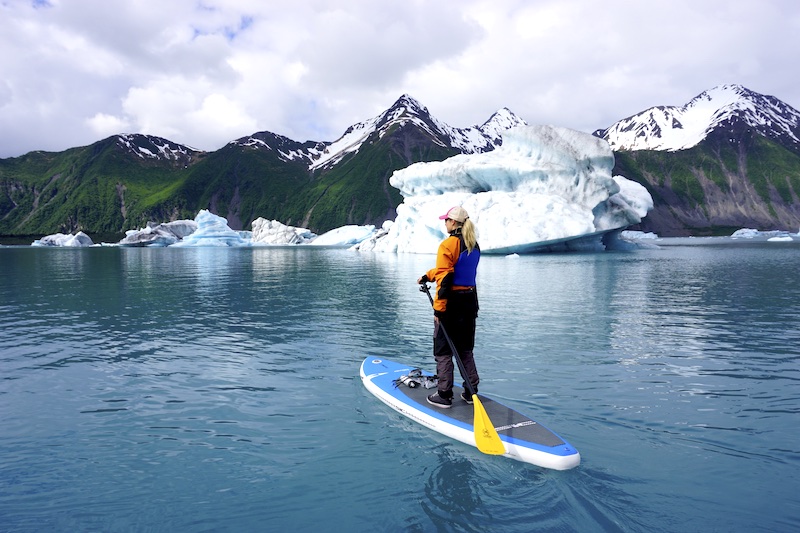
Want to keep stand-up paddling in the winter? I paddle year round and that means I need to be prepared for the changing weather.
If I go too long without getting on my board I start to crave it! Can you relate?
In the winter months I have no interest in freezing while out on the water, that’s not fun. However with the right gear and protection I can not only keep paddling in the colder weather but actually REALLY enjoy it.
As long as the water hasn’t frozen over you’ll find me out there. Granted not as often as in the warmer months but I’m usually game to make a go of it.
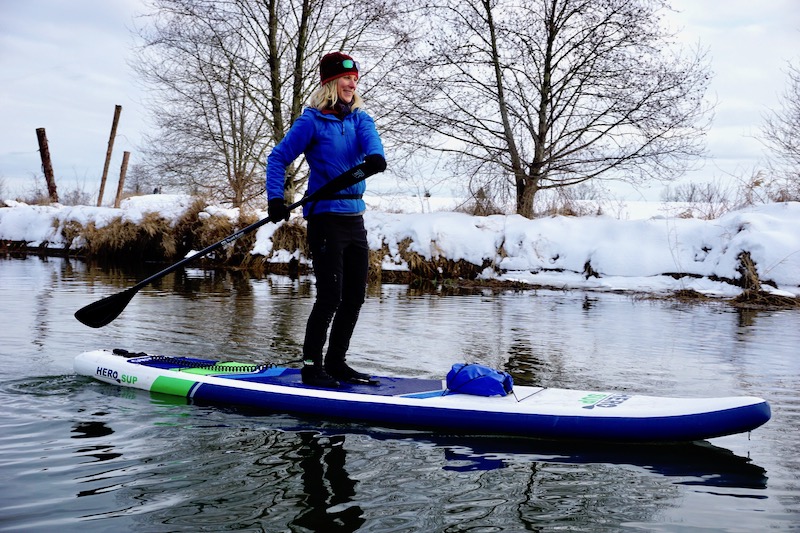
There are a couple of advantages that I find winter paddle boarding to offer.
- For one I find that I am often the only one out paddling and I love the peace and quiet. There are no (or very very few) power boats, no loud noises, no chaotic crowds. I will often have the whole area to myself (and whoever else is paddling with me). Consequently I find winter paddle boarding can be extremely peaceful.
- It is also very exhilarating. As with any winter sport you will likely find that being out in the fresh cool air will feel invigorating. As an added bonus, after a good couple hours working out in cold weather you might also find that you sleep better at night.
So, let’s take a look at exactly what needs to be thought of before and during your paddle session as well as what you should wear to stay warm and dry so you can keep paddling right up until the Spring thaw.
Cold weather paddling gear can add up but it doesn’t have to cost a fortune. You probably already have several of the necessities in your wardrobe.
TIP #1 – BE WELL PREPARED
There are a few steps to take before you hit the water that will help with comfort and warmth.
WARM DRINK
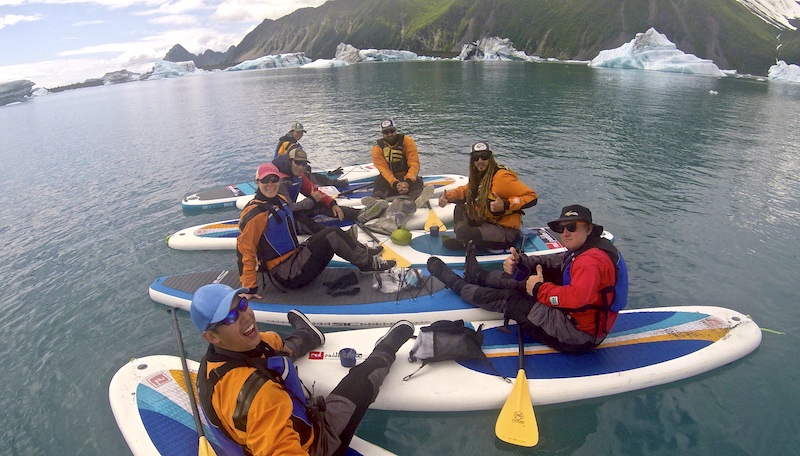
I take a thermos of tea with me in my car on the way to the water. I drink a cup on the way there and save some for after the paddle.
I find it not only very comforting but it also helps to warm me up when I am done.
Sometimes I will bring a thermos of tea out for the paddle as well to share with friends. I love taking a quick break for some hot tea.
A hot beverage is just one of those little extras that can make the experience even better.
SAFETY EQUIPMENT
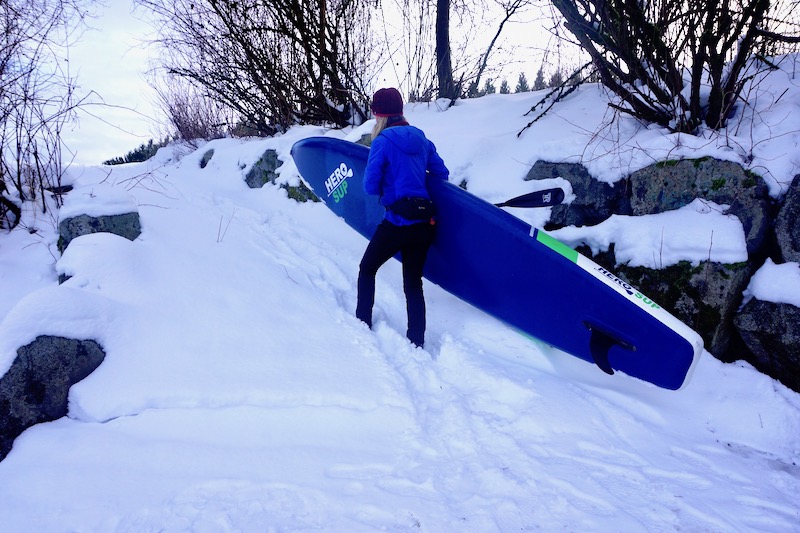
Double check that you have all your safety equipment with you before leaving home such as:
LEASH – If your board came with a leash, use it! If it didn’t I would highly recommend getting one. A 10′ leash will do the trick.
Secure the leash to your back D-ring and to your ankle. The last thing you want is to fall in and have your board swept away. Your paddle board can be your most important life saver.
DRINKING WATER – In cold weather I don’t always feel the need to drink water while paddling whereas in the summer I can go through a lot.
However I do feel it is important to have some with you even if you don’t use it, especially if you are going to be on the water for longer than an hour.
Bringing hot water in a thermos can be a great idea.
DRY BAG – You will need a dry bag to store a few extra safety items.
EXTRA CLOTHES – Bring extra clothing for after the paddle. If you fall in or get wet these will be critical.
You might also want to stuff an extra couple of layers into a dry bag to bring out on the board with you as well.
Examples of extra clothing you may want to bring in a dry bag are an extra pair of gloves, scarf, long sleeve top and especially an extra pair of wool socks.
PFD – A proper life jacket or PFD belt will not only help with extra insulation but it is paramount to actually wear one (not just keep it on your board) for winter paddling.
The water can be so cold that you may freeze up very quickly if you fall in. This can make it much harder to swim. Be smart and wear your PFD.
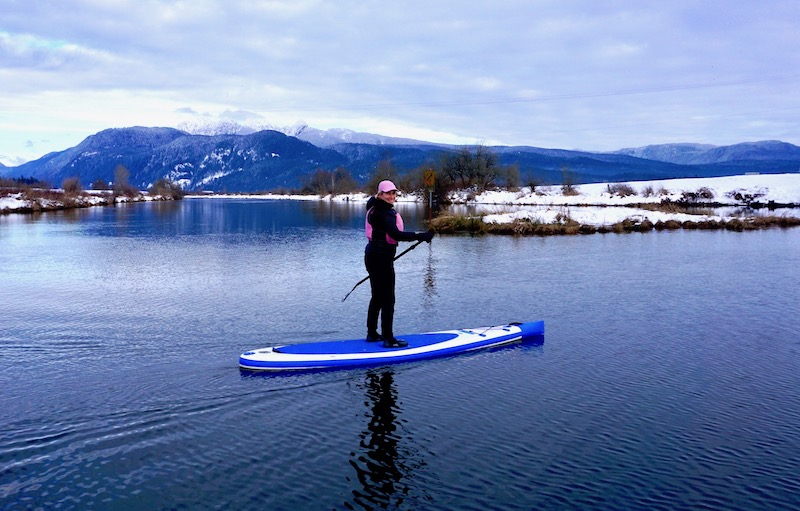
CELL PHONE – Keep your cell phone in your dry bag to use in case of emergency.
TELL A FRIEND

Before heading out tell a friend or loved one where you are going and what time you expect to be back.
Safety is so important, especially in the winter months. Be smart and let someone know your paddling plan.
CHECK THE WEATHER
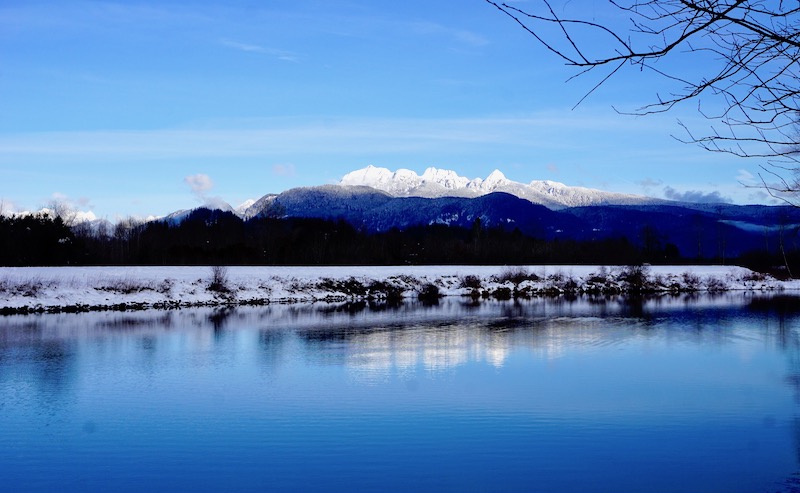
Next you will want to check out the weather report. Check the wind direction, temperature and overall forecast before getting on the water.
This isn’t always as important if just paddling along the shoreline of a calm lake but all the same it is a wise practice.
There is nothing worse than enjoying a nice day of paddling only to have to return to shore in a full out wind, rain or snow storm.
I’ve been caught having to paddle back in heavy wind a couple times and swore I’d never allow that to happen again. It can be scary, exhausting and dangerous.
TIP #2 – DRESS FOR THE WATER TEMPERATURE
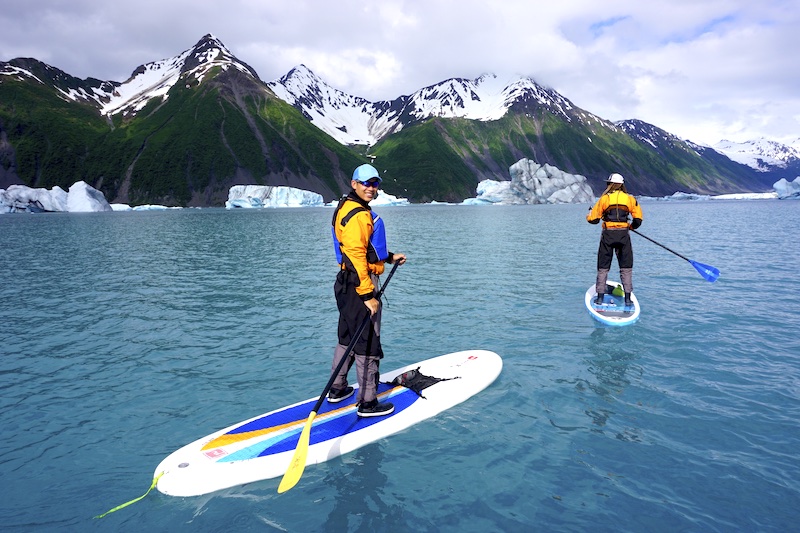
Nobody wants to fall in to freezing water. However falls can happen and you should dress for the water temperature as opposed to the air temperature.
So when choosing your layers consider wisely the body of water you will be paddling on, how far you will be from shore and how easily you can get to safety.
Start with your head, hands and feet. They need to stay warm in order for you to enjoy the experience.
HEAD
A fleece or neoprene tuque is great for the head. I am partial to a comfy fleece beanie. It doesn’t itch and keeps me warm.
HANDS
You will need some waterproof gloves or neoprene gloves for your hands.
I typically use my NRS paddling gloves, I have a few different pairs. However in really cold temps I don’t find they keep my fingers warm enough.
So I do sometimes simply wear regular winter gloves or mits, which are more insulated. However if there is a change you might end up in freezing water, neoprene gloves are critical.
For stand up paddling you don’t want your gloves to be too bulky but make sure they will keep your digits warm.
FEET
For your feet you have a few options…
- A pair of neoprene booties will keep your feet toasty. I use these paddle wetshoes from NRS. They have a mens and womens version for paddling and they are ideal for even the coldest days. Mine are almost a decade old at this point and they are still fantastic.
- If the temperature is icy I find that I need to add a pair of wetsocks as well. They can be worn inside your wetshoes. These are the ones I use at NRS. If the weather is chilly but not icy then I can sometimes get away with just wearing the wetsocks alone without the wetshoes. In a pinch instead of wetsocks you can also wear a pair of wool socks inside your wetshoes.
TIP: Although you want the wetshoes to fit snugly be careful not to get them too small or your wetsocks won’t fit inside.
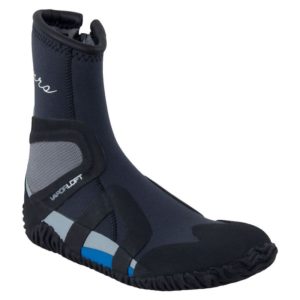
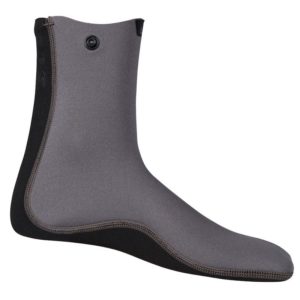
BODY
Although I do own a wetsuit I find that I rarely use it. Since my winter paddleboarding is mainly done on calm lakes and rivers where I stick fairly close to shore I usually make up my own layers.
If you are ocean paddling you might want to invest in a good wetsuit or drysuit. The wetsuit is ideal if you think you will end up in the water. The neoprene will trap the water against your body and keep it warm.
If it is unlikely you’ll end up in the water then a drysuit will be warmer and more comfortable as you can layer underneath.
For calm lake and river paddling this is what I normally wear.
For my bottom half I wear:
- A pair of fleece leggings
- Waterproof pants
For my top half I wear:
- A moisture wicking long sleeve t-shirt
- Fleece sweatshirt
- And a waterproof/windproof jacket
TIP: The most important thing to remember when planning your layers is to avoid cotton. Cotton will soak up moisture and water and cause you to get chilled very quickly.
TIP #3 – PLAY IT SAFE
Besides bringing along all your safety gear mentioned in tip #1 I would caution against one other very important detail…
The days are shorter and it gets dark early during the winter months.
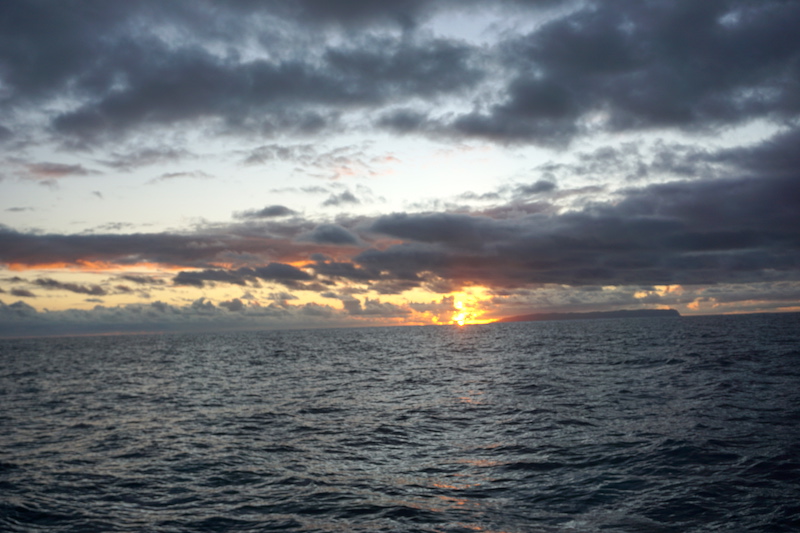
Plan your outing accordingly and if you think you will be out after dark or even in dusk then attach a waterproof white light to either your board or your body so that other boaters or people can see you.
I got caught a couple times where my paddle session took longer than expected and ended up returning in the dark.
Although it can be kind of a cool and eery feeling, it’s not the safest option.
If you want to watch the sunset from your board, do it closer to the end of your trip. That way you can quickly make it back to shore once the sun goes down.
At worst if you do get caught in the dark have a headlamp or other safety light with you.
Click here for more stand-up paddling articles, tips and advice.
 Health Benefits Of Stand Up Paddle Boarding
Health Benefits Of Stand Up Paddle Boarding Seth The Pup Who Loves To SUP
Seth The Pup Who Loves To SUP Must Have Apps for SUP Paddleboarding
Must Have Apps for SUP Paddleboarding Inflatable SUP Pros And Cons
Inflatable SUP Pros And Cons




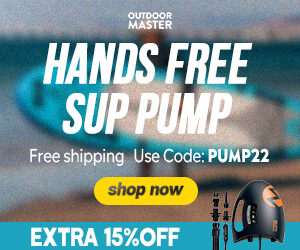
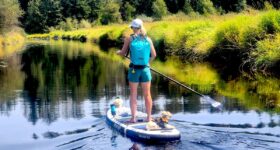


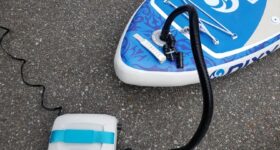
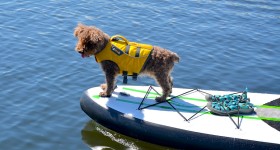

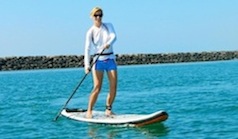
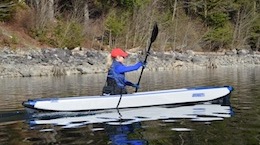
Thank you for the tips! I was really worried I wouldn’t get to enjoy being on the water this winter without spending a ton on a dry suit. I’ve found I can layer on top (like you mentioned) with waterproof pants (like yu mentioned) tucked into my knee high waterproof socks. I wear a pair of thick wool socks under the waterproof socks. I’m able to walk right into the water and get on my board.
I SUP in Morrk Bay (Central Coast of CA). I do t fall in on flat water. I am considering trying SUP in Sequim Bay, Port Townsend, and/or Port Ludlow. I understand looking at wind forecasts and tide here. Wondering how tides AND CURRENTS work up there? Any input appreciated.
corrections: Morro Bay And I do NOT fall in
I was wondering if all paddleboard can handle the cold water! I live in Quebec and it’s quite cold… I would really love to try paddleboarding during winter. I have a Bodyglove Performer 11 and can’t seem to find the information as if it’s okay on cold water. Thanks a lot for all these amazing tips! I’ll be trying hopefully soon! Marilie
Yes absolutely, the Body Glove board should be totally fine for cold weather paddling. Just dry the board off well after use and keep it stored inside. Also if you’re out all day be aware that the board air pressure can decrease slightly in the cold so you may need to top up slightly with the pump. However I’ve never had any issues when just out paddling for a couple of hours. Have fun!
hi Allison.
Could you, please, name the gear shops in the Vancouver area?
hey Allison, for the waterproof pants, do you tuck them into the booties or have them over the booties?
Technically you should be tucking them in for more protection but I usually just wear them over top. However only when I’m paddling close to shore in areas I feel I can safely get back without freezing to death if I fall in. For ocean paddling or longer adventures I tend to use a wetsuit with boots overtop.
I’d like to know where the above locations are. Where I live, there aren’t many lakes that don’t freeze in the winter.
A couple of the photos were from a trip to Alaska. The rest are from around where I live in Vancouver, BC. Our lakes rarely freeze over here so we can usually paddle year round. 🙂
Thank for these tips! safety measures should always be considered in doing SUP Paddling.